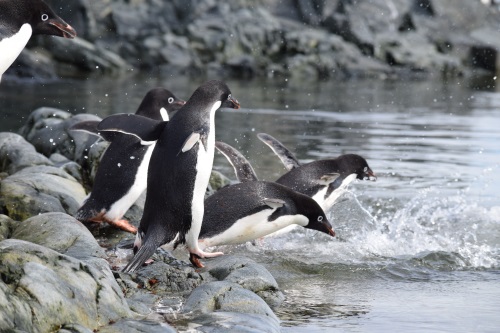Erin Pickett-
The Palmer LTER 2016 research cruise has come to an end and I am back at Palmer Station. In addition to a fantastic espresso machine, Palmer Station also comes with the added benefit of more internet bandwidth and a phone to call home. I thought while the memories are still fresh and my friends and family are beginning to ask, I’d better write down a few of my favorite field adventure moments.
Thinking back, there are a few common themes that all of these favorite moments have in common, and they are; high winds and snow stinging my face, dramatic cliff faces and rocky islands, shoes covered in penguin guano, sightings of whale spouts, and seabirds I have never seen before.
Overall, there were far fewer whales seen on this cruise than there have been in the past. Luckily, I was able to keep busy anyway, because when we weren’t finding whales I was assisting the seabird team in their pursuit of penguins. Toward the end of the cruise most of the science projects happening on the ship were wrapping up and the birders and whalers were given more freedom to direct the show. This meant we were able to work with the captain of the ship to chart courses to areas where we thought we might find whales and to rarely visited islands with colonies of Adelie, gentoo, and chinstrap penguins.
The first group of islands we visited were just east of Prospect point, called the fish islands. We used a handheld GPS and hand-drawn maps to navigate around a group of small rocky islands collectively named the minnows. Carrie and Darren (the “birders”) and I hopped on and off our skiff to count the chicks and adult penguins on each island. Meanwhile, our boat driver was keeping an eye on the wind and the icebergs surrounding us so that we wouldn’t find ourselves trapped in the bay if the sea ice became packed in by strengthening winds. Our ride back to the ship that day was quite wet due to a lot of wind chop, and we spent the rest of the afternoon drying our gear out and warming up so that we would be ready to return back to the minnows that evening to collect Adelie penguin diet samples.

Diet sampling is a critical part of the birders work during the LTER cruise. Collecting diet samples from Adelie penguins over a long time period and over large geographical distances allows us to monitor how changes in sea ice along the peninsula are impacting top predators and their prey. We had a successful trip back to the minnows that evening and collected fresh diet samples from five Adelie penguins that had just returned home from foraging trips.
Two days later we arrived at the Rosenthal islands, which are located on the west side Anvers Island. Our goal at the Rosenthal’s was to census the local penguin colonies. The Rosenthal’s were unlike anywhere else I have been yet, with jagged islands set dramatically near the base of a large glacier and waves crashing over nearby shoals and icebergs. Southern giant petrels and skuas glided over our heads while groups of penguins porpoised around us. At the first island we came to we got to see a king penguin, a rare sighting in this area.
Luckily there were six of us to count the thousands of Adelie, gentoo and chinstrap penguins that were scattered in colonies all over the islands, but it still took most of the day to complete our counts. After one last trip through the Gerlache straight at sunset, we arrived back at Palmer Station.
I hate to admit that I didn’t have my camera with me at Prospect point and at the Rosenthal’s, so until I get a few from the rest of the field team here are a few from the last week of the cruise…




















